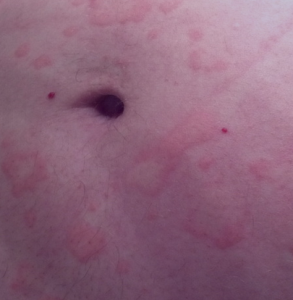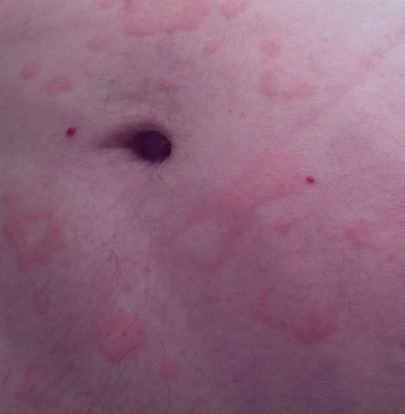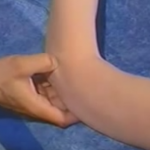Belly button also known as the navel is the remnant of the umbilical cord that forms a central scar on the abdomen. Itchiness around the umbilicus or belly button is common as the area is warm and moist making it susceptible to bacterial and fungal microorganism growth if not closely cared for. Itchiness of the belly button can be from an infection within or from rashes around it. Infections of the canal can be of a bacterial or fungal nature, and are usually accompanied by itching, foul smell, and secretion coming from the belly button.
Causes
Itchiness in the belly button can be caused by a number of scenarios. Foreign objects like body hair can enter the belly button canal and trigger an inflammatory reaction that causes an itchy sensation. The most common rash around the belly button would be a contact dermatitis, which is usually a reaction to allergens such as those in laundry detergents.
Bacterial infection of the belly button is often caused by dirt accumulated in the tract due to unhygienic standards, fostering the bacteria. Sweat, detergents and other harsh substances deposited in the canal aid in bacterial growth. Fungal infections in the belly button are often caused by Candida Albicans, a fungus that thrives in warm and moist areas. The fungus also causes yeast infections common in women’s urinary tract.
Environmental factors like lack of moisture in the atmosphere or swimming in contaminated waters can cause itchiness. Dermatological conditions like eczema and hives can also cause belly button itchiness. Diabetes is one of the lesser-known causes of belly button discomfort while high blood sugar affects the condition of the belly button causing it to itch and secrete a smelly cottage cheese like discharge.
In rare cases, itchiness of the belly button can be triggered by a sebaceous cyst, which in itself is none threatening, but any infection resulting from scratching will require treatment.
Itchy belly button during pregnancy
The skin is known to stretch during pregnancy. The area loses moisture and the skin tends to become dry, causing itching around the belly button. The woman may have the tendency to stratch the area, but should refrain from it, because it can lead to bacterial infestation. Keeping the area moisturized is the best way to stop the skin irritation.
Signs and symptoms
Bacterial and fungal infection in the belly button are accompanied by itchiness that results in swelling, mild pain, and a yellow or brown foul smelling discharge oozing out of the tract. The belly button tract becomes red, inflamed, sore and painful. The infected area is also warmer than other areas and may develop a mild rash.
In cases where itchiness is caused by a piercing gone wrong, bleeding may occur, accompanied by green, yellow or grey like pus from the navel. In rare cases, severe belly button infection, like that caused by piercings can lead to high fever and nausea.
When to call a doctor
If a piercing has gone wrong and caused belly button discomfort, contact a doctor immediately as the infection will rapidly grow. The belly button area can be affected by different skin rashes that also cause itchiness, some of which clear off without diagnosis. However, in case of redness, swelling or foul odor and secretions coming from the belly button, consult a doctor.

Itchy belly button treatment
There are many methods of treating itchiness of the belly button depending on the cause. If any foreign objects have entered the canal, seek a doctor’s help in extracting it. Attempting to extract the object at home may only irritate the belly button tract or push the object further in.
Infection of the belly button can be treated by a prescription of antibiotics or pouring a few drops of hydrogen peroxide into the belly button. You can apply the solution gently using a clean cotton bud, taking caution to keep the area clean.
Cleaning the belly button carefully with lukewarm water and antibacterial soap, then thoroughly drying before applying a topical antibacterial cream also clear mild infections. Fungal infection of the navel is treated by cleaning and drying the area before applying an anti fungal cream.
Home remedies
Washing the belly button gently and thoroughly paying attention to the folds and using a soft lintless cloth and a mild solution clears up most mild infections, before getting to the doctor’s office. Recommended solutions are warm salty water, tea tree oil, rubbing alcohol, white vinegar and aloe vera.
Belly button itchiness and secretions stemming from diabetes can be managed through control of blood sugars levels. Applying an itch blocking ointment, that does not contain irritant chemicals like vitamin E oil helps relieve the discomfort and keep off from scratching the area something that may aggravate the situation.
Prevention
Infection of the belly button can be prevented by trimming body hair around, using mild laundry detergents and cleaning the area and drying it thoroughly whenever taking a shower. When feeling itchy around the belly button, do not scratch; instead use a cream that soothes itching like calamine lotion or vitamin E oil.
If left untreated, itchiness of the belly button originating from infection may lead to development of abscesses. It can also spread to other parts of the body resulting in infection of the abdomen.

